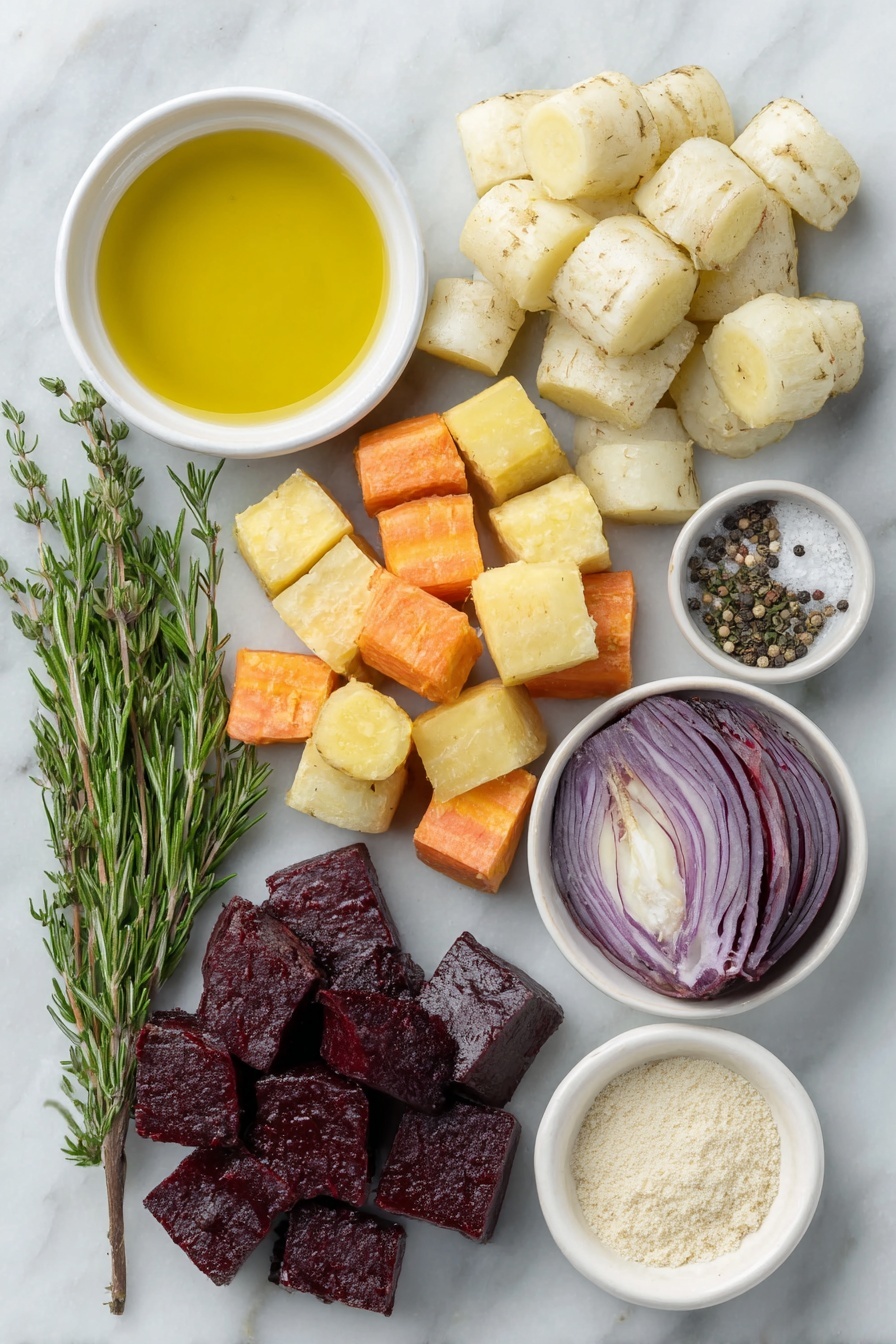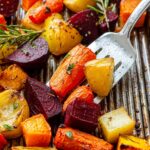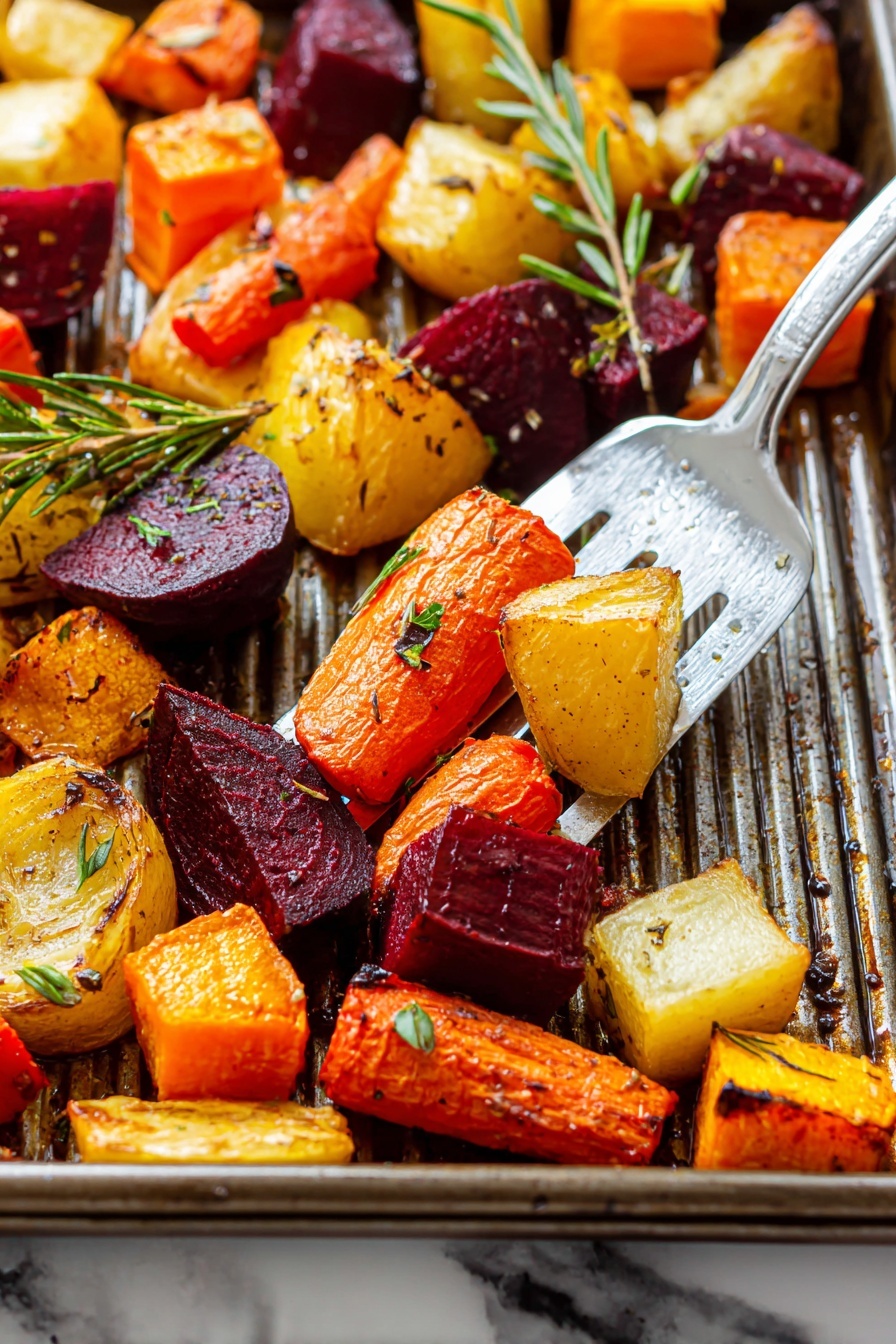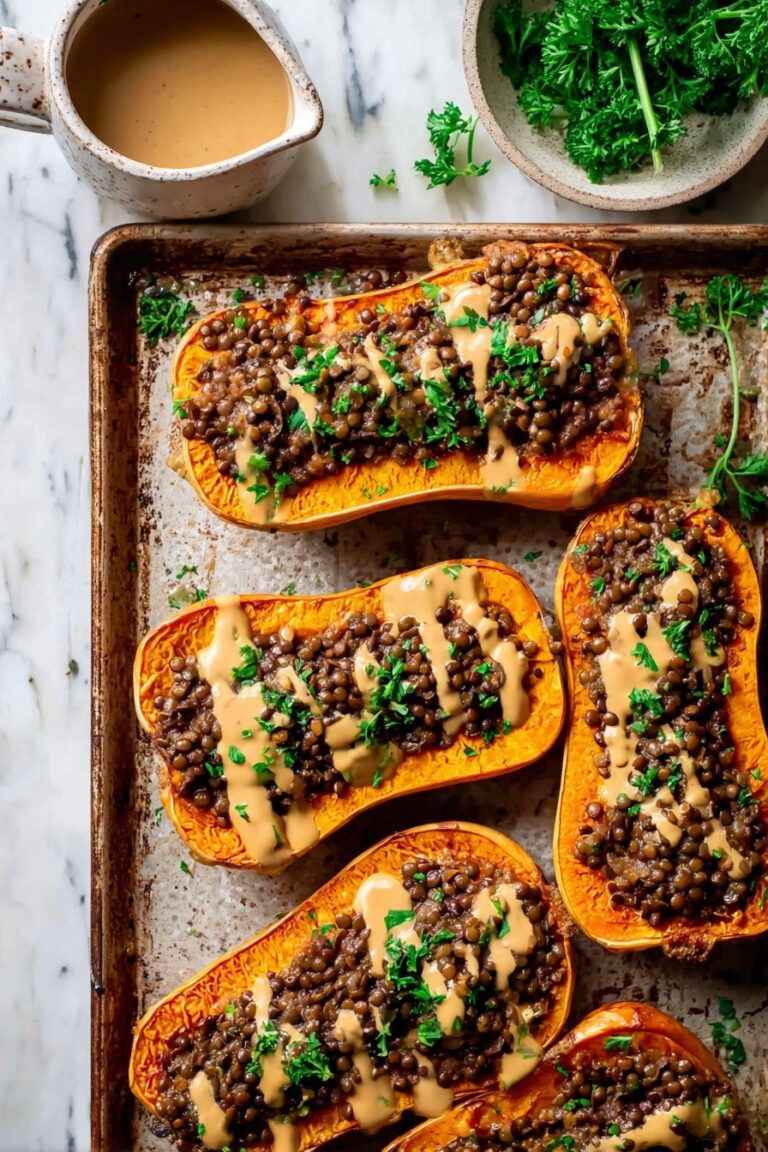Roasted Root Vegetables Recipe
If you’re on the lookout for a cozy, comforting dish to brighten up your dinner table, this Roasted Root Vegetables Recipe might just become your new go-to. It’s simple, flavorful, and perfect for any season—plus, it brings out the natural sweetness and earthiness of your favorite root veggies like nobody’s business. Trust me, once you’ve tried this, you’ll want to make it again and again.
Why This Recipe Works
- Balanced flavors: The combo of earthy beets, sweet carrots, and hearty sweet potatoes creates a beautiful depth in every bite.
- Simple seasoning: Fresh herbs like rosemary and thyme complement the vegetables without overpowering them.
- Perfect roasting temperature: Roasting at 425°F caramelizes the veggies just right for crisp edges and tender centers.
- Versatile and forgiving: This recipe works whether you’re feeding a crowd or meal prepping for the week.
Ingredients & Why They Work
Root vegetables are a dream to roast because of their natural sugars—they turn golden and sweet while staying hearty. When combined with fresh herbs and a touch of garlic, they develop an irresistible aroma and flavor. Here are the basics you’ll be working with and why I love each one.

- Carrots: Sweet and tender when roasted; I like to slice them evenly so they cook alongside other veggies perfectly.
- Parsnips: Earthy with a subtle sweetness; trimming larger pieces helps keep cooking times consistent.
- Beets: Their deep color and juicy texture add a vibrant, sweet note. Cutting into 1-inch cubes ensures they roast nicely without drying out.
- Sweet potato: Creamy and naturally sweet, they add body and richness to the mix.
- Red onion: Adds a punch of flavor and a little caramelized bite; I always separate the layers for better roasting coverage.
- Olive oil: Coats the vegetables to aid caramelization and to make sure the herbs stick.
- Fresh rosemary and thyme: These herbs bring a fresh, woodsy aroma that’s absolutely essential in any classic roasted root vegetable dish.
- Garlic powder: Adds gentle warmth and depth without risking burning like fresh garlic sometimes can.
- Sea salt & black pepper: The foundational seasonings that enhance all the natural flavors.
Make It Your Way
I love how flexible this Roasted Root Vegetables Recipe is. You can easily tweak it based on what’s in your fridge or your mood that day. From switching up herbs to adding a bit of spice, it’s all fair game—after all, cooking should be fun and personal!
- Variation: Once, I tossed in some cubed rutabaga along with the usual veggies and added a pinch of smoked paprika—it gave the dish a smoky twist that was a real crowd-pleaser.
- Dietary modifications: For those avoiding nightshades, sweet potatoes can be swapped with golden beets or turnips without losing flavor or texture.
- Seasonal changes: In autumn, adding diced acorn squash or chestnuts amps up the fall vibes beautifully.
Step-by-Step: How I Make Roasted Root Vegetables Recipe
Step 1: Prep Your Veggies Like a Pro
Start by peeling and chopping your carrots, parsnips, beets, sweet potato, and red onion into roughly the same size pieces—about half to one inch thick or cubed. This helps everything roast evenly, so nothing ends up overcooked or underdone. I like to work on a big cutting board to keep my workspace organized.
Step 2: Season for Success
Place all the chopped veggies in a large bowl. Drizzle with olive oil, then sprinkle chopped rosemary, thyme, garlic powder, sea salt, and black pepper on top. Toss it all together until every piece is evenly coated—this step really makes the flavors pop when roasting.
Step 3: Arrange & Roast
Spread the vegetables out on a large baking sheet in a single layer—crowding them will steam the veggies rather than roast them, and we don’t want that. Pop the pan into a preheated 425°F (218°C) oven and roast for about 25 minutes. You’ll want to check for tender, caramelized edges. If you love a little extra browning (and I always do), broil them for 3-5 minutes at the end, keeping a close eye so they don’t burn.
Tips from My Kitchen
- Uniform Cutting: I learned the hard way that if your pieces aren’t close in size, some veggies burn while others stay hard—so patience with chopping pays off.
- Use a Heavy Baking Sheet: A sturdy pan ensures even heat distribution, so your vegetables roast evenly without soggy bottoms.
- Toss Halfway Through: Give the veggies a quick stir at 12–15 minutes for even caramelization and to prevent sticking.
- Don’t Skip the Broil: Quickly broiling at the end adds that irresistible crispy edge that makes this dish truly crave-worthy.
How to Serve Roasted Root Vegetables Recipe

Garnishes
I love finishing these with a sprinkle of fresh parsley or a few crumbles of tangy feta to brighten up the earthy flavors. A drizzle of balsamic glaze adds a little zing and an extra layer of complexity—totally optional but highly recommended.
Side Dishes
These roasted root veggies work beautifully alongside roasted chicken, grilled steak, or even as the star of a vegetarian bowl with quinoa or couscous. I often pair them with a crisp green salad to add contrasting freshness.
Creative Ways to Present
For something special, I like to serve the roasted vegetables over creamy polenta or dolloped with herbed goat cheese. At holiday dinners, arranging them on a rustic wooden board with sprigs of rosemary makes for a stunning presentation that guests always admire.
Make Ahead and Storage
Storing Leftovers
Once cooled, I transfer leftovers to an airtight container and keep them in the fridge for up to 4 days. They reheat beautifully, making weeknight dinners a breeze.
Freezing
I’ve frozen leftover roasted root veggies in portioned containers without any problem. Just make sure they’re completely cool before freezing, and use within 2 months for the best flavor and texture.
Reheating
The best way I’ve found to reheat these is in a hot oven (about 400°F) for 10–15 minutes to bring back some of that crisp roasted edge — the microwave tends to make them a bit soggy. For a super quick fix, a hot skillet with a little olive oil works great too.
FAQs
-
Can I use frozen root vegetables for this Roasted Root Vegetables Recipe?
While fresh vegetables give the best texture and flavor, you can use frozen root vegetables if that’s what you have. Just thaw and pat them dry before roasting, and expect the cooking time might be a bit shorter since frozen veggies tend to release more moisture.
-
What’s the best way to store leftovers?
Store cooled roasted root vegetables in an airtight container in the fridge for up to 4 days. When reheating, use an oven or skillet to bring back that roasted crispness.
-
Can I add other root vegetables?
Absolutely! Turnips, rutabagas, and even kohlrabi work beautifully. Just make sure to cut everything into similar sizes for even roasting.
-
Is it necessary to broil at the end?
Not necessary, but highly recommended! Broiling for a few minutes adds delicious caramelized edges and texture that really elevate the dish.
Final Thoughts
This Roasted Root Vegetables Recipe feels like a warm hug in food form—perfectly sweet, herby, and comforting. I keep coming back to it not just because it’s delicious, but because it’s so easy to pull together with minimal cleanup. I truly think that once you make it your own, this dish will find its way onto your regular rotation. So give it a whirl, share it with friends or family, and enjoy the simple joy of roasting nature’s sweetest gifts.
Print
Roasted Root Vegetables Recipe
- Prep Time: 10 minutes
- Cook Time: 25 minutes
- Total Time: 35 minutes
- Yield: 6 servings
- Category: Side Dish
- Method: Baking
- Cuisine: American
- Diet: Vegetarian
Description
This Roasted Root Vegetables recipe features a colorful medley of carrots, parsnips, beets, sweet potatoes, and red onions seasoned with fresh rosemary, thyme, garlic powder, and perfectly roasted to caramelized tenderness. It makes a delicious and healthy side dish that is easy to prepare and packed with natural flavors.
Ingredients
Vegetables
- 5 medium carrots (~6 oz; peeled and sliced 1/2 inch thick)
- 4 medium parsnips (~11 oz; peeled and sliced 1/2 inch thick, cut larger pieces in halves or quarters)
- 2 medium beets (~8 oz; peeled and cut into 1-inch cubes)
- 1 large sweet potato (~12 oz; peeled and cut into 1-inch cubes)
- 1 medium red onion (~6 oz; peeled and cut into 1.5-inch pieces, layers separated)
Seasonings & Oil
- 1/4 cup olive oil
- 1 tablespoon fresh rosemary, chopped
- 1 tablespoon fresh thyme
- 3/4 teaspoon garlic powder
- 1 teaspoon sea salt
- 1/4 teaspoon black pepper
Instructions
- Preheat the oven: Set your oven temperature to 425 degrees Fahrenheit (218 degrees Celsius) to prepare for roasting the vegetables evenly.
- Combine vegetables and oil: In a large bowl, add the chopped carrots, parsnips, beets, sweet potato, and red onion. Drizzle with 1/4 cup olive oil to coat all pieces.
- Season the vegetables: Add the chopped fresh rosemary, fresh thyme, garlic powder, sea salt, and black pepper to the bowl. Toss everything together until the vegetables are evenly coated with the oil and seasonings.
- Arrange on baking sheet: Spread the seasoned vegetables in a single layer on a large baking sheet. If your pan is not non-stick, spray it with cooking spray or lightly brush with olive oil beforehand to prevent sticking.
- Roast the vegetables: Place the pan in the preheated oven and roast for about 25 minutes, until the vegetables are tender and caramelized around the edges.
- Optional browning: For extra browning and crispness, move the pan about 6 inches under the broiler and broil for 3 to 5 minutes, watching carefully to avoid burning.
Notes
- Cut vegetables into uniform sizes to ensure even cooking.
- Use fresh herbs for best flavor, but dried rosemary and thyme can be substituted; use about 1 teaspoon each if dried.
- If broiling, watch closely as vegetables can burn quickly.
- Use a large baking sheet to avoid overcrowding, which can cause steaming instead of roasting.
- This dish pairs well with roasted meats or can be served as a vegetarian main with grains.
Nutrition
- Serving Size: 1 cup
- Calories: 150 kcal
- Sugar: 7 g
- Sodium: 300 mg
- Fat: 7 g
- Saturated Fat: 1 g
- Unsaturated Fat: 6 g
- Trans Fat: 0 g
- Carbohydrates: 22 g
- Fiber: 5 g
- Protein: 2 g
- Cholesterol: 0 mg









